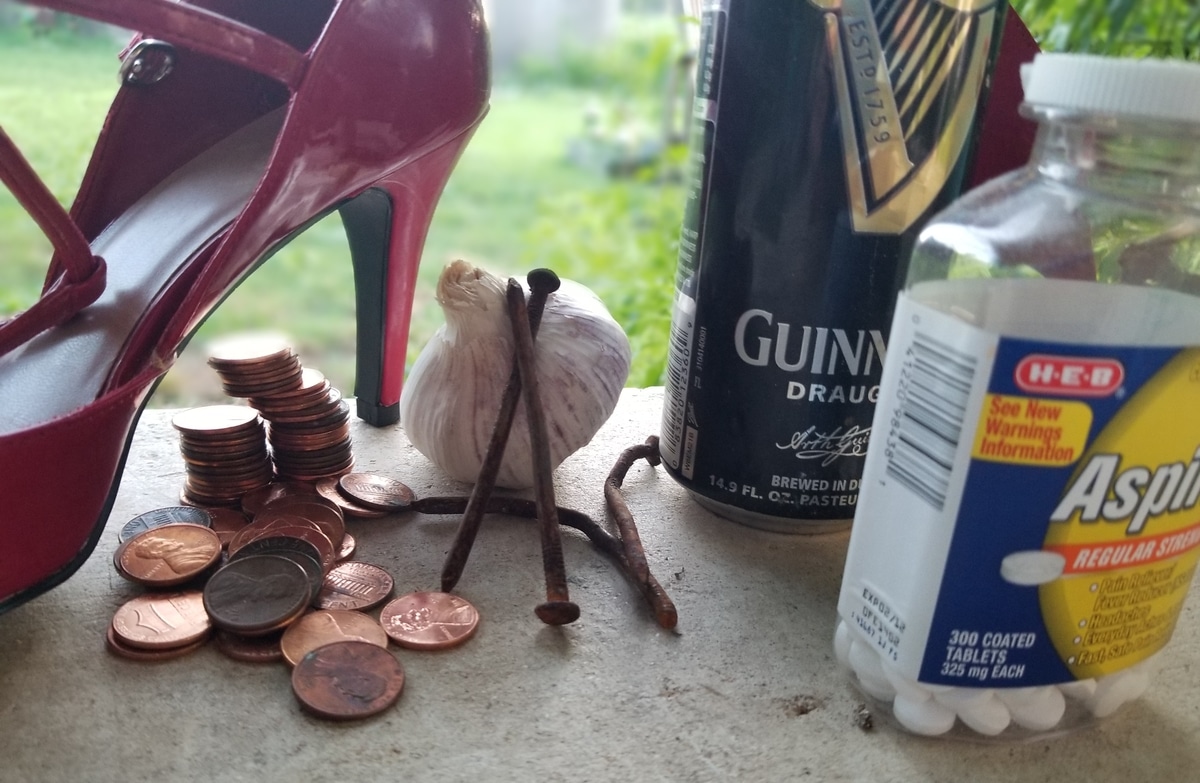
If it’s your good fortune to own and preen a sizable chunk of vibrant green lawn, chances are good that you spend part of your spare time at your closest garden center, loading up bags of fertilizers, powders and sprays to keep your turf looking pert. But a century or two ago, how in the world did they do it?
Folksy home remedies, that’s how. And while these off-the-shelf if not downright unhygienic lawn treatments might make us cringe today, a lawn diet that included rusty nails, pennies, aspirin, garlic and pee all proved effective if limited before more streamlined solutions became available.

“There’s a lot of truth in what people come up with, and then if you can get several people to say they have tried it and it worked, it may be good,” admits Mike Robertson, owner of Mike’s Garden and author of The Gulf Coast Landscape. “I wouldn’t necessarily take it from one person, but if several people have had success, then maybe.”
Here are 8 folkie lawn remedies for curious try-it-yourselfers, along with their more effective/simpler modern updates.
1. Rusty Nail Punch
Iron drives photosynthesis, the energy-producing process that creates the chlorophyll necessary to maintain a vibrant green lawn. To feed the need, early gardeners would throw a handful of iron-rich rusty nails into a watering bucket to steep, creating the iron kick their lawn required.
“It makes sense,” Robertson admits. “If you didn’t have fertilizer with the three numbers – nitrogen, phosphorus, potassium – they may not have had fertilizers with micronutrients like iron that they now put in there.”
Update: Modern fertilizers typically include a dash of iron. Want more? Consider Ironite (1% iron) or Milorganite (2.5%).
2. Stiletto Heels
In dense soil, a lawn can struggle if the nutrients it needs can’t penetrate to the roots. Ancient footloose gardeners solved the problem by donning spiked heels and dancing a turf tango or two, letting their heels perform the aeration.
“In clay soils that compact easily, it’s a good idea to aerate,” Robertson agrees. “Here on the Gulf Coast of Florida, I’m on a peninsula that 5,000 years ago used to be a barrier island, so it’s nothing but sand. There’s really no use to aerate here.”
Update: Depending on your soil, try aerator shoes, an aerator probe or a rolling garden aerator or motorized chipper.
3. Beer Spray
Back in the day, throwing a sudsy beer on the brown spots may have seemed like a great way to introduce yeast to solve the problem. Unfortunately, beer yeast promotes fungus growth. “The alcohol and sugar won’t help either,” adds Robertson.
Update: Leave your beer on the patio and stick with a multipurpose fertilizer like Scotts Turf Builder.
4. Pennies
Speaking of fungus, our ancestors used to throw handfuls of pennies onto their lawns, hoping that the copper would serve as an effective fungicide.
“I’ve never tried it, but the alternative of not having the copper as micronutrients would matter to the grass if it was deprived of it,” Robertson says.
Update: Save yourself the change and spray instead with Liquid Copper fungicide.
5. Grass Tea
Like us, the ancients understood that letting mowed grass remain on the lawn helps recycle nutrients into the soil. But the old sods invented a clever way to nurture their soil and still have a clean yard to enjoy by dumping their grass clippings into a water-filled barrel and brewing nitrogen-rich tea with which to water the lawn. It works, but not quickly.
Update: Compost tea combines rotted grass and leaves into a nitrogen-rich brew that reaches a lawn’s roots faster than mowed clippings.
6. Aspirin Cocktail
Sure, you might swallow an aspirin or two after mowing the back 40, but have you ever thought of slipping one into your lawn? Turns out the acetylsalicylic acid in aspirin helps boost the immune system in most plants, accelerating germination and fending off pests and disease. One to two aspirin dissolved in a gallon of water and applied biweekly also promotes root growth.
Update: T-Nex Plant Growth Regulator and similar products help make turfgrass stronger, greener and slower growing to minimize mowing.
7. Garlic
Ancient gardeners used garlic cloves or tea to stave off the parasites that pester lawn roots.
“I know that garlic can stave off moles; they don’t like garlic,” says Robertson. “Today, we spray castor oil on your lawn. It doesn’t kill the moles but it runs them out of your lawn.”
Update: Nixalite’s Mosquito Barrier, made of 99% garlic juice, will not only rid your lawn of mosquitoes, ticks, fleas, black flies, and gnats, but will send armadillos, deer, field mice, geese and rabbits packing as well.
8. Human and Pet Urine
Although Robertson has not tried it personally, he’s seen how effective nitrogen-rich urine can be as a grass fertilizer. “When a dog pees on a lawn, one way that you can identify that it’s not a fungal thing but just dog pee is that right at the edge of where they peed, it will be very green but the center dead,” he recalls. “I wouldn’t want to apply it or spray it out though.”
Ancients used a ratio of 10 parts water to one part urine to reduce the negative acidity and salt levels of their otherwise effective mix.
Update: Zip up – there are plenty of plant fertilizer products such as Verde that combine urea with other micronutrients to green up your lawn so you don’t have to.